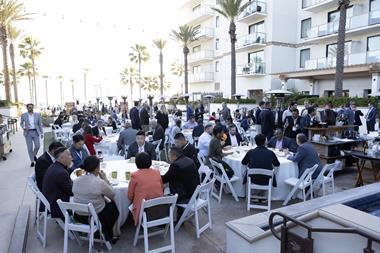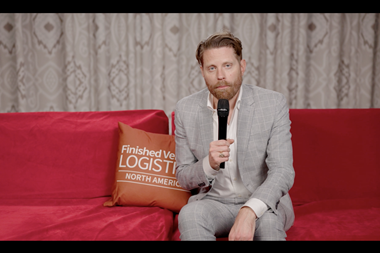CATL’s Aleksej Kruekov discusses with Megan Kelly the challenges in digitalising automotive logistics, including lack of truck interoperability, geopolitical restrictions, and operational silos that reduce efficiency, and how CATL is addressing these issues through transparency and investments in new technologies
Before joining CATL in 2021, Aleksej Kruekov worked at BMW for more than a decade as lead buyer for high voltage lithium-ion cells and cell modules. Now, in his role as general manager of overseas service, EMEA, he is applying his knowledge of the EV logistics industry at the Chinese battery manufacturer, using his experience in both the OEM and supplier side of the spectrum to drive collaboration and the successful digitalisation of the supply chain.
Importance of collaboration for digitalisation in automotive logistics
The rise of EVs is pushing the drive towards digitalising the industry even further, with new technologies becoming more important as the battery supply chain emerges and grows. This new layer of logistics and the trend towards localisation in the battery supply chain requires even more visibility, with inbound supply of scare raw materials, and finished vehicle logistics requiring changes to be made to accommodate battery transportation and storage.
“Digitalisation provides tools to enhance communication, transparency and real-time decision-making, which ensures more resilient operations,” says Kruekov. “Such tools are especially important with the rise of electrification in the automotive industry, because the supply chain becomes even more complex considering delivery of critical raw materials, battery transportation, maintenance and recycling.”
The EV industry is fast moving, and so are the digital technologies being developed to enhance it, and in order to keep up, the industry needs to collaborate.
Kruekov says collaboration is “crucial” for successful digitalisation. “Without collaboration between OEMs, suppliers and logistics providers, the digitalisation of the whole supply chain is barely possible, which will make the industry less competitive,” he says.

Barriers to collaboration between automotive OEMs and the supply chain
The biggest barrier to collaboration, according to Kruekov, is lack of standardisation and data integration. On top of this, in such a global industry, different companies in different regions will adhere to varying restrictions or regulations on data sharing.
Companies usually hold critical information in isolated systems, and with a lack of easily accessible or sharable data, it becomes difficult to collaborate in real time.
He says another reason is a lack of trust or willingness to share data due to increasing competition in the automotive logistics industry. “Competition drives innovation, but in terms of data integration it becomes more difficult to collaborate effectively,” he says, “therefore we need to think of new approaches to overcome that challenge.”
“The best way to build trust is to remove it from the equation” – Aleksej Kruekov, CATL
The industry is fragmented when it comes to software, something that was reflected in our recent Automotive Logistics Systems & Software Survey 2024. The survey found that the large number of individual software providers combined with the profusion of proprietary, in-house and custom-made software remains a real challenge and opportunity across inbound and FVL. In inbound logistics, SAP was the leading software provider, but only 14% of the respondents used it, while 10% used in-house software and 49% of respondents chose ‘other’ rather than using a market leading brand – showing just how fragmented the industry is when it comes to aligning on software. On top of this, many of the respondents who work in inbound logistics (28%) said they would develop in-house software or customise software to their needs.
Kruekov says most companies will continue using their own platforms, processes and tools until a new universal platform or software is adopted by the industry, which seems unlikely in the short-to-medium-term. Until then, he says the industry needs to start bringing supply chain stakeholders together with technology providers to develop standardised protocols and enable fast and secure data exchange between different systems and platforms. He says this will reduce compatibility issues and improve communication.
Building trust and transparency in data-sharing
“The best way to build trust is to remove it from the equation,” says Kruekov. By this, he means that trusting another party to safely store data and sensitive information should not be an “entry requirement” in collaboration. He says that using blockchain technology can help ensure data is immutable and transparent, eliminating the need to speculate on the trustworthiness of other parties.
He says: “In a blockchain-enabled supply chain, every transaction or data update is recorded on a decentralised ledger that all network participants can access. This provides an indisputable record of any movement and ensures transparency. During my last years at BMW, we already had multiple projects in the pipeline to utilise the potential of Distributed Ledger Technology within the supply chain.”
Distributed Ledger Technology (DLT) is a system that allows multiple participants to share copies of ledgers across a network of computers without requiring a central authority or system, where exchanges are verified using a consensus protocol that is visible to all parties.
Investing in cyber security measures is another way to demonstrate commitment to protect shared data, something Bosch’s vice-president of privacy and information security, Ekaterina Serban, spoke about at ALSC Digital Strategies Europe last year.
“She specifically pointed out why data protection is important and which measures should be taken to ensure safe information sharing,” says Kruekov. “With the use of blockchain or Distributed Ledger Technology, decentralisation actually became possible. The network is self-sufficient and self-paying, which was the biggest point of vulnerability before.”
He adds: “Building trust is challenging, but I believe that in the automotive logistics and supply chain sector it is possible through a combination of strong governance, secure data-communication protocols and adoption of new technologies like blockchain.”
How CATL has partnered with OEMs and suppliers to strengthen digitalisation
CATL has worked to strengthen its digitalisation in its approach to predictive maintenance. Through digital tools, including digital twins, the company is able to detect or address issues in their EV battery products and their logistics before they escalate.
“Using this innovative approach, we at CATL can guarantee proactive product safety prior to delivery, rather than depending on reactive maintenance after issues arise,” Kruekov explains. He says the technology can calculate the failure rate of the battery components throughout their life cycle and ensure battery safety in shipments while meeting storage and transport regulations.
“With our predictive algorithms we can monitor every single cell in real time inside the battery and automatically generate early warnings, should the system require maintenance or repair,” he says. “This helps predict failures, reduce downtime and optimise the delivery of spare parts or replacement batteries, which significantly improves both logistics efficiency and customer satisfaction.”
Fostering digital collaboration in automotive logistics for the long-haul
With rapid changes in technology and in the automotive industry itself as it continues its journey towards electrification, stakeholders need to be able to revise digital roadmaps and remain flexible in their approach.
To do this, there needs to be a culture of communication, continuous improvements and innovations. “Encouraging regular, open communication between partners is the best way to ensure alignment on goals, requirements, and expectations,” says Kruekov. “Using collaborative digital platforms and data integration protocols that can ensure data protection, trust and transparency are a great place to start.”
Another way to help nurture trust for years to come is in flexible contracts that account for uncertainties and changes in demand, something that Lucid Motors’ Sid Philar, senior manager of global logistics procurement also previously told Automotive Logistics. Philar emphasised that effective logistics partnerships hinge on the right IT investments, fair contract negotiations and robust communication processes. “It’s about ongoing communication and regular feedback in areas like pricing and operations,” he explained, highlighting the importance of a collaborative approach. “It’s a two-way street; it’s not just about squeezing the supplier,” he said, underscoring the need for mutual benefits.
Similarly, Kruekov says contracts should encourage collaborative problem-solving rather than focusing on penalties. “When the stakeholders see data as a zero-sum game, they are less likely to be open and transparent, hence do not have enough motivation to collaborate,” he says. “Building a culture that emphasises the mutual benefits of data sharing and digitalisation is the backbone for successful cooperation. Everything comes with a price tag, so demonstrating that sharing data will benefit both parties builds long-term trust, thus enhancing collaboration.”
Aleksej Kruekov, general manager of overseas service, EMEA at CATL will be speaking at Automotive Logistics and Supply Chain Digital Strategies Europe 2024.
The conference, which will run from 3-4 December in Munich, Germany, will discuss how to form a more co-creative, resilient and sustainable supply chain.


























![Global[1]](https://d3n5uof8vony13.cloudfront.net/Pictures/web/a/d/s/global1_726550.svgz)














No comments yet